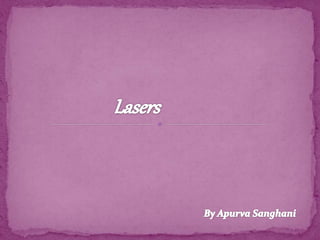Lasers
- 3. ï Laser is a device which can produce a highly intense, highly choerent, more directional and highly monochromatic beam. ï Laser is an acronym for light amplification by stimulated emission of radiation. ï In laser intensity of light is amplified by a process called stimulated emission. ï Lasers are optical phenomena which find major application in various fields. ï Example : Fiber Optic Communication,Industries,etc. ï Lasers are more poweful radiation than ordinary light radiation.
- 4. ï The following characteristics , distinguishes a laser beam from an ordinary light. They are four type. The wave trains which are identical in phase and direction are called coherent waves. ï Since all the constituent photons of laser beam possess same energy, momentum and propagate in same direction, laser beam is said to be highly coherent.
- 5. : It has ability to focus over a small area of 10âŧâķ cmÂē. : Laser travels as a parallel beam it can travel over a long distance without spreading.The angular spread of a laser beam is 1 mm/meter. : The light from a normal monochromatic source spreads over a rang of wavelength of the order 100 mm but the spread is of the order of 1 mm for laser.
- 6. 1. Induced Absorption : ï Let the atom be initially in the lower state Eâ. ï If a photon of energy h v is incident on the atom in the lower state, the atom absorbs the incident photon and gets excited to the higher energy state Eâ. ï This process is called induced aborption. Induced Absorption
- 7. 2. Spontaneous Emission : Emission of a light photon takes plce through an inducement i.e. by an extemal photon. ï It is not a random process. ï The photons get multiplied through chain reaction. ï It is a controllable process. ï It is more intense. ï Monochromatic radiation. Spontaneous Emission
- 8. 3. Stimulated Emission : Emission of light photon takes place immediately without any inducement. ï It is a random process. ï The photons do not get multiplied through chain reaction. ï It is an uncontrollable process. ï It is less intense. ï It is a polychromatic radiation. Stimulated Emission
- 9. ïActive Medium : oThis is a four level solid state laser system. oYttrium Aluminium Garnet(Y3Al5O12),commonly known as YAG,doped with neodymium ions NdÂģâš is the active medium. oThe neodymium inos NdÂģâš are the active centers. ïResonator Cavity : oThe end face of Nd:YAG rod ground polished and silvered to act optical resonator mirrors using tow external reflecting mirrors Mâ and Mâ.
- 10. ïOptical Pumping : oA xenon flash lamp or a krypton flash lamp is used as a pumping source. ïConstruction : oThe schematic diagram of a Nd:YAG is shown in here
- 11. ïApplications Of Nd:YAG : ï§ These laser are widely used for cutting,drilling,welding and surface hardening of the industrial products. ï§ Military as range finder and as target designations. ï§ Medical field for cataract surgery etc. ï§ Long haul communication. ï§ Study of inertial confinement fusion.
- 12. ï Some of the Applications Of Laser in various fields are listed below. 1) In Industry : ï Welding and melting. ï Cutting and drilling holes. ï To test quality of materials.
- 13. 2) In Medicine :
- 14. 4) Onther Use :















